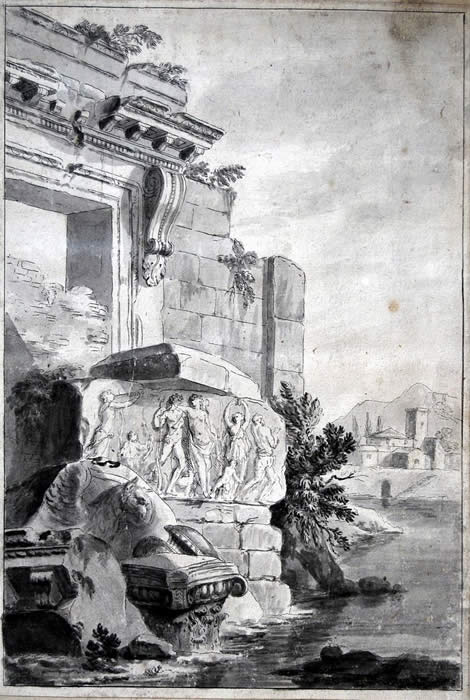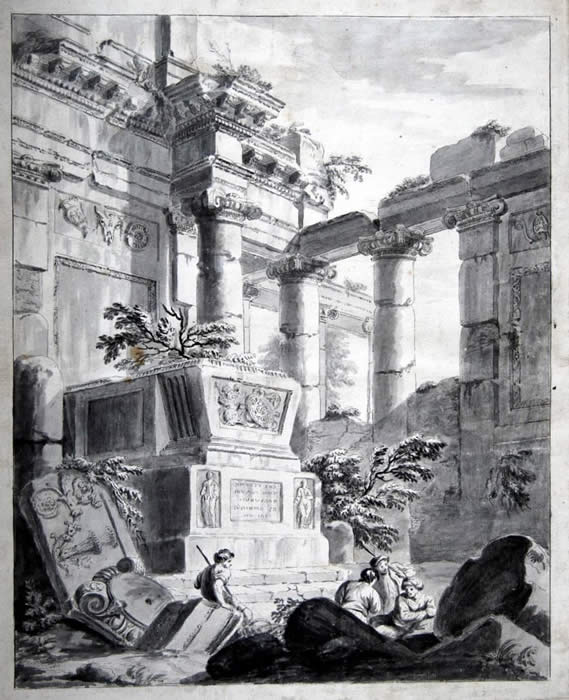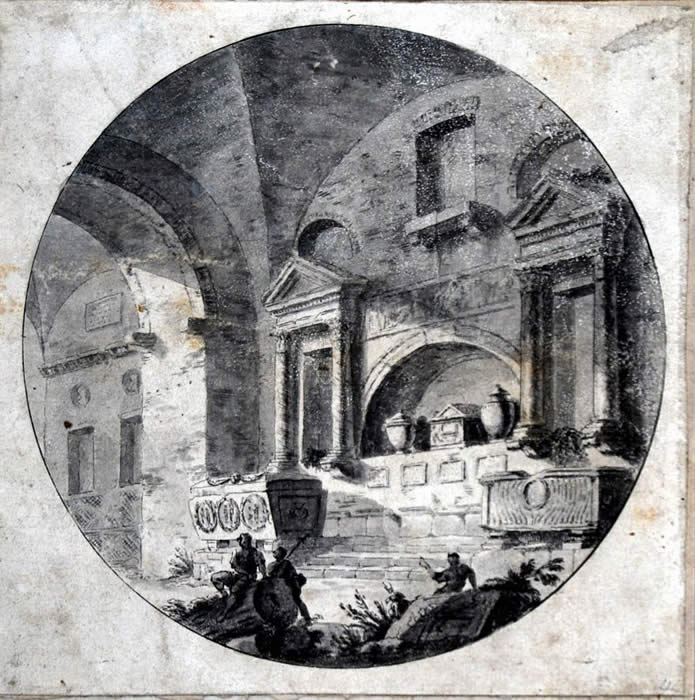
ROMAN RUINS |
|
|---|---|
|
|
 |
 |
|
 |
|
CLERISSEAU, Charles Louis. ROMAN RUINS, a group of fourteen vedute di fantasia black ink with grey and brown wash shading over fine etched outline.
Rome: (circa 1770). 14 original manuscript drawings, of which 6 (14 x 11 1/2 in.) and 8 (7 x 7 in.) and 1 circular.
A collection of Clerisseau's Fantasia collected by his near contemporary, James Paine (1717-1789).
Charles-Louis Clerisseau, artist, architect, and archaeologist won the Prix de Rome in 1746 and studied under Pannini at the French Academy in Rome from 1749 to 1754. There he absorbed the influence of his close friends Piranesi and Winckelmann and after 1754 became tutor in architectural drawing and theory first to William Chambers then to Robert Adam with whom he travelled widely between 1754 and 1757.
The influence on the Adam brothers developing neo-classical style was immense, the wealth of delicate ancient-inspired decorations, vaulted ceilings, screens of columns, niches, and rooms in a great variety of shapes often inspired from Clerisseau.
Clerisseau also heavily influenced American architecture when he was commissioned by Thomas Jefferson to execute drawings for the proposed state capitol building in Richmond, Virginia. Jefferson met Clerisseau at Paris in 1785 and found that he was the only suitable 'Architect whose taste had been formed on a study of ancient models of this art.' (McCormick, p. 191).
The present group of drawings all appear to be vedute de fantasia, imaginative works incorporating elements drawn from observation.
The majority are drawings in gouache over fine etched outline, this method is not an uncommon technique for eighteenth century artists. The only Clerisseau composition over an etching to be hitherto recorded appears to be that of the circular drawing of a mausoleum or sepulchral hall. An example of which is included in this collection.
The other examples are recorded of this image, one at the Hermitage is in collection of Clerisseau's drawings bought by Catherine the Great in 1779. It is
illustrated online and as no. 59 in the Louvre catalogue (see below) and is described as the only example of a drawing over etching in that collection. The other example, with minor variations of detail and shading, is in the Fitzwilliam Museum. A version in gouache - Clerisseau's more usual medium - is in Sir John Soane's Museum (Inv. P.97).
This points to a hitherto unsuspected working practice that Clerisseau used during the middle years of the eighteenth century. Another example included in this group is also illustrated as fig. 113 in McCormick's work; however, there it is signed by Charles Natoire! A careful comparison between the two versions show the size, proportions perspective and outline to be exactly the same, however the treatment of shading and detail could not be more different.
The only reasonable possibility is that Clerisseau's working methods included producing very fine etchings that were then very carefully finished with gouache, pen ink and wash with enough variation that they often look on even quite close inspection as separate works. Charles Natoire may have acquired some of these outlines through his role as director of the French Academy in Rome, even though he and Clerisseau were not on good terms.
It is also probable that fig. 123 and 124 in McCormick's work illustrating an 'Architectural Interior' are wrongly interpreted. The first of these images show a full composition, the second only a section in outline that is on the verso of another smaller gouache. Although this section is described as an underdrawing it more likely to be part of a discarded sheet. Although McCormick described Clerisseau as working a pencil sketch into an ink drawing it is more probably that this is an etched outline with some additional perspective lines being added in pencil. The dating of this work has been problematic since he produced many subjects with only minor variations over a period of more than three decades. This is more understandable if we look on the drawings as having the same basic fine etched outline but with an overlay of gouache reflecting the changing taste or particular commission.
Clerisseau was selling his work to Grand Tourists by 1753, exhibited his architectural capricci in London in the early 1770s and continued to work in similar style in St. Petersburg and Paris well into the 1780s. While James Paine visited Rome in 1755, the highly accomplished use of ink and wash of these drawings suggests that this group was probably purchased by Paine at one of the London exhibitions in the early 1770s.
Light browning to two drawings; a few old creases and very small rubbed spots; mounted on large folio sheets of laid paper; from a disbound section of a larger album collected by the architect James Paine.
References Thomas J. McCormick, Charles-Louis Clerisseau and the Genesis of Neo-Classicism, 1990; Charles-Louis Clerisseau: dessins du musee de l'Ermitage Saint-Petersburg, Musee de Louyvre, 1995.
SOLD